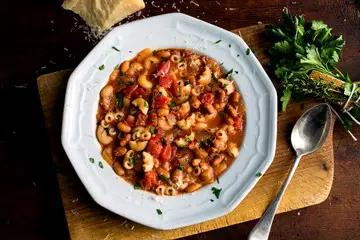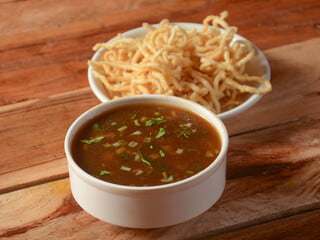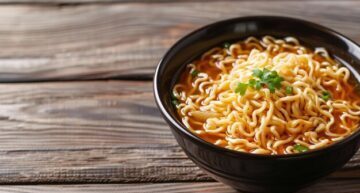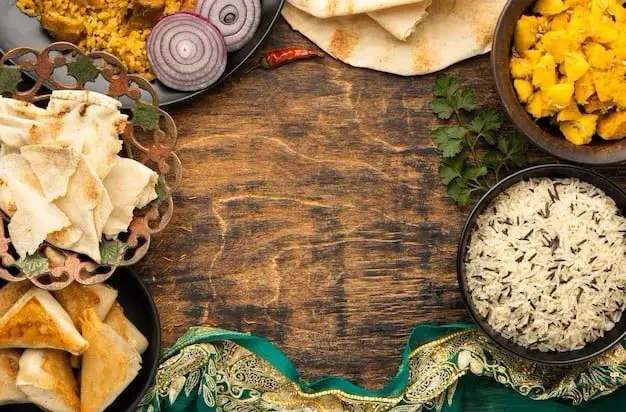Hey there, food friends! Today we’re diving into the warm, comforting world of pasta e fagioli. Now, I know what you’re thinking – “Pasta and beans? That sounds… basic.” But hold onto your spoons, because this Italian classic is about to rock your taste buds!
Let’s start with the basics. Pasta e fagioli (that’s “pasta and beans” for those of us who don’t speak Italian) is like the superhero of soups. It’s hearty, it’s filling, and it’s got a flavor that’ll make your grandma jealous. Plus, it’s so easy to make that you might just retire from ordering takeout forever.
Table of Contents
The Story Behind the Soup
Okay, gather ’round, because it’s storytime. Pasta e fagioli isn’t just some random dish someone threw together when they couldn’t decide between pasta night and bean night. Nope, this bad boy has history.
Way back when, in the not-so-glamorous parts of Italy, people had to get creative with their cooking. They didn’t have fancy ingredients or Gordon Ramsay yelling at them in the kitchen. What they did have was beans (cheap and filling) and pasta (also cheap and filling). So, they thought, “Hey, why not throw these together and see what happens?”
And boy, did something magical happen. This peasant dish became so popular that it spread all over Italy faster than you can say “mamma mia!” Each region put its own spin on it, kind of like how every family has their own secret recipe for chocolate chip cookies.
In the north, they like their pasta e fagioli thick and creamy, almost like a stew. Down south, it’s more of a soup situation. Some folks add tomatoes, some don’t. Some use white beans, others go for the red ones. It’s like a “choose your own adventure” book, but with food!
The Ingredients: Let’s Break It Down
Now, let’s talk about what goes into this bowl of goodness. Don’t worry, I’m not gonna give you a shopping list longer than your arm. Pasta e fagioli is all about simple ingredients that pack a flavor punch.
1. Pasta: We’re not fancy here. Any small pasta will do. Ditalini is traditional, but elbows, small shells, or even broken spaghetti work just fine. The pasta police won’t come knocking, I promise.
2. Beans: Cannellini beans (Small Rajma) are the classic choice, but don’t stress if you can’t find them. Great northern beans or navy beans are perfectly good stand-ins. Heck, throw in some red kidney beans if you’re feeling rebellious!
3. Veggies: We’re talking basics here – onions, carrots, and celery. This trio is called “soffritto” in Italian cooking, and it’s the base for, like, a million dishes. It’s like the boy band of the vegetable world – each one brings something to the table, but together they’re magic.
4. Tomatoes: Some recipes use ’em, some don’t. If you do, a can of crushed tomatoes or a couple of diced fresh ones will do the trick.
5. Broth: Chicken or vegetable, whatever floats your boat (or in this case, your pasta).
6. Herbs and Seasonings: Garlic (because, duh), rosemary, thyme, maybe a bay leaf if you’re feeling fancy. Salt and pepper, of course. And if you want to get really authentic, throw in a Parmesan rind while it’s cooking. It’s like a flavor bomb for your soup.
7. Extras: Some folks like to add a bit of pancetta or bacon for extra flavor. Others throw in some greens like spinach or kale at the end. You do you, friend.
Here’s a list of the utensils needed for making pasta e fagioli:
- Large pot or Dutch oven
- Cutting board
- Sharp chef’s knife
- Wooden spoon or heat-resistant spatula
- Measuring cups (for both dry and liquid ingredients)
- Can opener (if using canned beans or tomatoes)
- Colander or strainer (for rinsing beans and potentially draining pasta)
- Ladle (for serving)
- Vegetable peeler (for carrots)
- Garlic press (optional, can use knife to mince garlic instead)
- Large spoon for stirring
- Cheese grater (for Parmesan, if serving)
- Soup bowls (for serving)
Optional but helpful:
- Immersion blender (if you want to partially blend the soup for a creamier texture)
- Kitchen scale (if you prefer weighing ingredients)
- Timer (to keep track of cooking times)
These utensils will cover everything you need to prepare, cook, and serve your pasta e fagioli.
Instructions:
Now, before we start cooking, let me tell you a little secret. The key to a great pasta e fagioli is patience. This isn’t a quick weeknight dinner you can whip up in 20 minutes. This is a labor of love, a dish that needs time to develop its flavors. So pour yourself a glass of wine, put on some good music, and let’s get started.
Step 1: The Bean Situation
If you’re using dried beans (and I highly recommend you do), you’ll need to soak them overnight. Just pop them in a bowl, cover them with water, and let them do their thing. In the morning, drain and rinse them. If you’re using canned beans, just drain and rinse them. Easy peasy.
Step 2: The Veggie Prep
Grab your knife and cutting board, because it’s time to chop some veggies. Dice your carrots, celery, and onion. This trio is known in Italian cooking as “soffritto” and it’s the base of many delicious dishes. Mince your garlic too while you’re at it.
Step 3: The Flavor Base
Heat the olive oil in a big saucepan over medium heat. Toss in your diced veggies and garlic. Let them sweat it out for about 5 minutes until they’re soft and fragrant.
Step 4: Bean Time
Add your beans to the pot along with the crushed tomatoes, broth, rosemary, and thyme. Bring everything to a boil, then reduce the heat and let it to simmer. Now here’s where that patience comes in – let this baby simmer for about an hour and a half. I know, I know, it’s a long time. But trust me, it’s worth it. This is when all those flavors start to meld together into something truly special.
Step 5: Pasta Party
About 10 minutes before you’re ready to eat, add your pasta to the pot. Cook it until it’s al dente. Remember, the pasta will continue to cook a bit in the hot soup, so don’t overdo it.
Step 6: The Final Touch
Season with salt and pepper to taste. And here’s another little secret – a splash of good olive oil right at the end will take this dish from great to mind-blowing.
Now, ladle that beautiful soup into bowls, sprinkle some Parmesan on top, and get ready for a taste explosion.
But wait, there’s more! (I’ve always wanted to say that)

Why This Soup Rocks
Let’s talk about why pasta e fagioli is basically the superhero of soups:
1. It’s Budget-Friendly: Beans and pasta are cheap, my friends. This is a meal that’ll feed a crowd without breaking the bank.
2. It’s Flexible: Don’t have cannellini beans? Use whatever beans you’ve got. No ditalini pasta? Throw in some elbows. This soup is not here to judge.
3. It’s Healthy(ish): I mean, it’s not a kale smoothie, but it’s got veggies, it’s got protein from the beans, and it’s not deep-fried. I’d call that a win.
4. It’s Comforting: There’s something about a bowl of pasta e fagioli that just feels like a hug from the inside out. It’s perfect for cold days, sick days, sad days, or just “I need something delicious” days.
5. It’s Even Better the Next Day: Like a fine wine or your favorite jeans, pasta e fagioli just gets better with time. The flavors have a chance to really get to know each other overnight in the fridge.
Variations on a Theme
Now, I know some of you out there are thinking, “But I want to make it my own!” Well, fear not, creative cooks. Here are some ways you can put your own spin on pasta e fagioli:
- The Meat Lover’s Version: Brown some ground beef or Italian sausage before you start the soffritto. It’ll add a deep, rich flavor to your soup.
- The Veggie Enthusiast’s Delight: Throw in some zucchini, bell peppers, or whatever vegetables you’ve got lurking in your crisper drawer. More veggies = more awesome.
- The Spice Fiend’s Dream: Add a pinch of red pepper flakes or a dollop of harissa paste if you like things hot. Just don’t go overboard – we want to taste the soup, not breathe fire.
- The “I Can’t Believe It’s Not Pasta” Version: Use small cauliflower florets instead of pasta for a low-carb option. It’s not traditional, but it’s pretty darn tasty.
- The “Green Machine” Variation: Stir in a big handful of chopped kale or spinach at the end for an extra nutrient boost.
Tips and Tricks for Pasta e Fagioli Success
- Don’t Overcook the Pasta: Nobody likes mushy pasta. Cook it just until it’s al dente – it’ll continue to soften in the hot soup.
- Save Some Pasta Water: If you cook your pasta separately, save some of the starchy pasta water. It’s great for thinning out the soup if it gets too thick.
- Mash Some Beans: Want a creamier soup? Use a potato masher to smush up some of the beans. It’ll give your soup a thicker, more luxurious texture.
- Parmesan Rind is Your Friend: Seriously, don’t throw those rinds away. They add an incredible depth of flavor to soups and sauces.
- Let It Rest: Like a good steak (or a toddler after a sugar high), pasta e fagioli benefits from a little rest. Let it sit for 5-10 minutes after cooking to let the flavors meld.
Some important FAQs about pasta e fagioli:
- What does “pasta e fagioli” mean?
“Pasta e fagioli” is Italian for “pasta and beans.” It’s pronounced “pah-sta eh fah-joh-lee.” - Is pasta e fagioli a soup or a pasta dish?
It’s actually both! It’s often referred to as a soup, but it’s thick enough to be considered a pasta dish as well. The consistency can vary depending on personal preference and regional variations. - What type of beans should I use?
Traditionally, cannellini beans are used, but you can also use borlotti beans (cranberry beans) or even navy beans. Some variations use a mix of different beans. - What kind of pasta works best?
Small pasta shapes work best. Ditalini is traditional, but you can also use small shells, orzo, or even broken spaghetti. - Is pasta e fagioli vegetarian?
It can be! While some recipes include pancetta or prosciutto, many versions are completely vegetarian. Just make sure you use veggie broth rather than chicken broth. - Can I make pasta e fagioli in advance?
Yes, it actually tastes better the next day as the flavors have time to meld. However, the pasta may absorb more liquid, so you might need to add some broth when reheating. - How long does pasta e fagioli last in the fridge?
Properly stored in an airtight container, it should last 3-4 days in the refrigerator. - Can I freeze pasta e fagioli?
Yes, but it’s best to freeze it before adding the pasta. When you’re ready to eat, thaw the soup, reheat it, and then cook the pasta fresh in the soup. - Is pasta e fagioli healthy?
Yes! It’s packed with fiber from the beans and vegetables, and provides a good balance of carbohydrates and protein. It’s a nutritious, filling meal. - What’s the difference between pasta e fagioli and minestrone?
While both are Italian soups with beans and pasta, minestrone typically includes a wider variety of vegetables and sometimes meat. Pasta e fagioli focuses more on the pasta and beans.
Health Benefits of Pasta e Fagioli:
- High in Fiber: The beans and vegetables provide a good amount of dietary fiber, which aids digestion and promotes feelings of fullness.
- Protein-Rich: Beans are an excellent source of plant-based protein, essential for muscle building and repair.
- Complex Carbohydrates: The pasta and beans offer complex carbs, providing sustained energy.
- Rich in Vitamins: The vegetables (like carrots, celery, and tomatoes) provide various vitamins, including Vitamin A, C, and K.
- Mineral Content: Beans are a good source of iron, potassium, and magnesium.
- Heart-Healthy: The combination of fiber, plant-based protein, and low saturated fat content can contribute to heart health.
- Weight Management: The high fiber and protein content can help you feel full longer, potentially aiding in weight management.
- Antioxidants: Tomatoes provide lycopene, a powerful antioxidant.
- Low in Fat: Especially if made with vegetable broth, this dish is typically low in fat.
- Versatile for Diets: It can be easily adapted for various dietary needs (vegetarian, vegan, gluten-free).
Now, let’s look at an approximate nutrition chart for a typical serving of pasta e fagioli (about 1 cup or 250ml):
Nutrition Chart for Pasta e Fagioli (per 1 cup serving):
| Nutrient | Amount | % Daily Value* |
|---|---|---|
| Calories | 250-300 | – |
| Total Fat | 3-5g | 4-6% |
| Saturated Fat | 0.5-1g | 3-5% |
| Cholesterol | 0mg | 0% |
| Sodium | 500-600mg | 22-26% |
| Total Carbohydrate | 45-50g | 16-18% |
| Dietary Fiber | 8-10g | 29-36% |
| Sugars | 5-7g | – |
| Protein | 12-15g | 24-30% |
| Vitamin A | – | 15-20% |
| Vitamin C | – | 15-20% |
| Calcium | – | 8-10% |
| Iron | – | 15-20% |
*Percent Daily Values are based on a 2,000 calorie diet. Your daily values may be higher or lower depending on your calorie needs.
Please note that these values can vary based on specific recipes and ingredients used. This chart provides a general idea of the nutritional content of a typical pasta e fagioli dish.
- The combination of beans and pasta provides a complete protein source, making it an excellent option for vegetarians and vegans. The high fiber content (8-10g per serving) is particularly noteworthy, as it contributes to digestive health and helps maintain stable blood sugar levels.
- While the sodium content might seem high, you can reduce this by using low-sodium broth and limiting added salt. The low fat content, especially saturated fat, makes this a heart-healthy option.
- Remember, pasta e fagioli can be part of a balanced diet, providing a mix of carbohydrates, proteins, and vegetables in one comforting dish. As with any food, moderation is key, and it’s always a good idea to pair it with a variety of other nutritious foods throughout your day.
Conclusion
So there you have it, folks. Pasta e fagioli: the soup that’s more than just a soup. It’s a warm hug on a cold day, a satisfying meal that won’t break the bank, and a little taste of Italian history in every spoonful.
Whether you’re a cooking newbie or a seasoned chef, pasta e fagioli is a dish that welcomes all. It’s forgiving, flexible, and always delicious. Plus, it’s the perfect excuse to practice your Italian accent (just maybe not in public).
So the next time you’re standing in front of your pantry, wondering what to make for dinner, remember the humble yet mighty pasta e fagioli. Whip up a pot, pour yourself a glass of wine (or grape juice, we don’t judge), and enjoy a little taste of Italy right in your own kitchen.
And hey, if anyone asks where you got this amazing recipe, just wink mysteriously and say it’s an old family secret. Your secret’s safe with me.
Buon appetito, food friends!
Pasta e fagioli recipe
This hearty pasta e fagioli recipe combines tender cannellini beans with small pasta shapes in a flavorful tomato-based broth. Aromatic vegetables like onions, carrots, and celery form a savory base, while garlic, rosemary, and thyme add depth and warmth. The dish simmers slowly, allowing the flavors to meld into a comforting, rustic Italian soup. Perfect for chilly days, this one-pot meal is both satisfying and nutritious, offering a balance of protein, fiber, and complex carbohydrates. Topped with a sprinkle of Parmesan cheese, it's a simple yet delicious example of traditional Italian comfort food that's sure to become a family favorite.

Ingredient List
Instructions
-
- Heat the olive oil in a large pot over medium heat. Add the onion, carrots, and celery. Cook, stirring occasionally, until the vegetables have softened, about 5-7 minutes.
- Add the minced garlic and cook for another minute until fragrant.
- Add the rosemary, thyme, and bay leaf. Stir to combine.
- Add the cannellini beans, crushed tomatoes, and broth. If using, add the Parmesan rind. Bring the mixture to a boil, then reduce heat and simmer for about 15-20 minutes to allow the flavors to meld.
- Add the pasta to the pot and cook until al dente, usually about 8-10 minutes. Stir occasionally to prevent the pasta from sticking to the bottom of the pot.
- Once the pasta is cooked, remove the herb sprigs, bay leaf, and Parmesan rind (if used).
- Taste and adjust seasoning with salt and pepper as needed.
- Stir in the chopped parsley.
- Serve hot, topped with grated Parmesan cheese and extra parsley if desired.
Note
- If the soup becomes too thick, you can thin it out with additional broth or water.
- For a creamier texture, you can mash some of the beans before adding them to the pot.
- This soup tends to thicken as it cools, so you might need to add more liquid when reheating leftovers.










